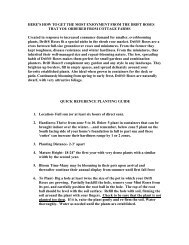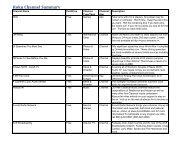QVC IN THE GARDEN RobeRta's GaRdens - QVC.com
QVC IN THE GARDEN RobeRta's GaRdens - QVC.com
QVC IN THE GARDEN RobeRta's GaRdens - QVC.com
You also want an ePaper? Increase the reach of your titles
YUMPU automatically turns print PDFs into web optimized ePapers that Google loves.
Frequently<br />
Asked questions<br />
WHAT IS <strong>THE</strong> BEST WAY TO USE <strong>THE</strong>SE <strong>IN</strong><br />
LANDSCAPE?<br />
Jupiter’s Beard is widely used in wildflower<br />
meadows and water garden fringes, as well as<br />
in more civilized borders. The blossoms are long<br />
lasting as cut flowers. They are especially easy to<br />
arrange because flowers pushed to face a different<br />
direction from the stem will stay in their new<br />
positions obediently, which is where the plant got<br />
its name.<br />
IS DEADHEAD<strong>IN</strong>G NECESSARY?<br />
This plant responds very well to pinching the<br />
growing tip out in mid spring. This helps it produce<br />
a bushier plant with more flowers. It also benefits<br />
from a cutting back by a third after the first flush<br />
of flowers as it will re-flower in late summer.<br />
HOW DO YOU PREPARE FOR W<strong>IN</strong>TER<br />
DORMANCY<br />
Leave last of old flower heads on the plant. Just let<br />
them naturally die back. Remove any foliage that<br />
still remains the following spring. This is usually<br />
very minimal.<br />
HOW OFTEN CAN <strong>THE</strong>Y BE DIVIDED<br />
Clumps should be divided every 2 -3 years in<br />
spring.<br />
WHAT ARE SOME NICE COMPANION PLANTS?<br />
Peonies, monarda, digitalis, delphinium, scabiosa,<br />
campanula, dianthus, and hardy geranium make<br />
nice <strong>com</strong>panions.<br />
First things First...<br />
When your plant arrives from Roberta’s, remove from the<br />
shipping box immediately.<br />
Remove plastic bag and/or sleeve from around potted<br />
plant(s). Discard any packing material clinging to the<br />
leaves or soil. Pull away any yellow or brown leaves that<br />
may have occurred during transit. If you can not plant it<br />
into garden or larger pot within a few days, make sure it<br />
stays well watered.<br />
When ready to plant, do the job as early in the day as<br />
possible to avoid extreme soil temperatures that prevent<br />
proper water uptake from the roots. Water them in well<br />
and whisper a few words of wisdom.<br />
Thank you for your order!<br />
Take your gardening experience to new heights by<br />
visiting Roberta’s Unique Gardens in our brand shop<br />
on <strong>QVC</strong>.<strong>com</strong>. Our goal is to enhance your gardening<br />
enjoyment by providing you with top quality, leading<br />
edge perennials and annuals that are suitable for your<br />
garden and home with the best service imaginable.<br />
Roberta’s is a 4th generation family owned business<br />
and has been one of the leading <strong>com</strong>mercial exhibitors<br />
at flower and garden shows for over 50 years in the U.S<br />
and abroad. We search the globe to find easy-to-grow<br />
plants that are unique in themselves or their variety<br />
making them nearly impossible to find elsewhere. Our<br />
passion and <strong>com</strong>mitment continually asks the question,<br />
“What makes a better, unsurpassed, and more beautiful<br />
flower to behold?”<br />
Working with growers and breeders from all over the<br />
world, Roberta’s is able to bring you hard-to-find plants<br />
and new species that will be sweethearts for years to<br />
<strong>com</strong>e. Our alliance with <strong>QVC</strong> since the late 1990’s will<br />
continue to transform your garden into the garden<br />
of your dreams. “Partnering with <strong>QVC</strong>, we share a<br />
<strong>com</strong>mon vision that puts the customer at the top of<br />
the list!”<br />
Thank you for bringing us into your home,<br />
Eric, Kevin, and Koort Wallien<br />
1-800-428-9726<br />
Monday – Friday 8:30 am – 4:30 pm EST<br />
Thank you<br />
for bringing us into your home<br />
www.robertasinc.<strong>com</strong><br />
<strong>QVC</strong>, the Q and the Q-Ribbon Logo are service marks of ER Marks, Inc.<br />
<strong>QVC</strong> in the garden<br />
RobeRta’s <strong>GaRdens</strong><br />
planting and growing guide<br />
Jupiter’s Beard<br />
(Centranthus)
light/sun exposure:<br />
usdA<br />
hArdiness zones:<br />
plAnting distAnce:<br />
mAture height/spreAd:<br />
)<br />
bloom time:<br />
plAnting instructions:<br />
(soil preparation, depth,<br />
which end is up, etc.)<br />
1<br />
step<br />
2step<br />
3step<br />
4step<br />
quick reFerence<br />
plAnting guide<br />
Full Sun to Partial Sun<br />
4 to 9<br />
2-3 feet<br />
2-3 feet<br />
2-3 feet per plant<br />
Late Spring - Autumn<br />
Remove plastic bag and/or sleeve from around<br />
potted plant(s). Discard any packing material<br />
clinging to the leaves or soil. Transplant into<br />
the garden as soon as evening temperatures<br />
stay above 40F.<br />
plAnting guide<br />
Remove plastic bag and/or sleeve from around potted<br />
plant(s). Discard any packing material clinging to the leaves<br />
or soil. Pull away any yellow or brown leaves or spent flowers<br />
that may have occurred during transit. If you cannot plant it<br />
into garden or larger pot within a few days, make sure it stays<br />
well watered.<br />
Transplant into the garden as soon as evening temperatures<br />
stay above 40F. Dig holes twice the width of the root ball and<br />
about 5 to 6 inches deep. Place them in their holes. Pack soil<br />
firmly around roots. Fill with soil and pack in firmly covering<br />
entire root zone. Water again. Plants prefer full sun to half<br />
day of sun.<br />
Rather than in the garden you may re-pot into large<br />
containers. Repot the plants into at least 10 inch pots<br />
separately or together inside one larger container.<br />
Planted now they will produce flowers in late spring to<br />
autumn.<br />
continuing cAre AdditionAl reFerence<br />
SHELF LIFE<br />
Plant into garden or larger pots and place outside<br />
immediately after the night temperatures stay above 40<br />
degrees.<br />
PLANT PREPARATION<br />
Remove plastic bag and sleeve from around potted<br />
plant(s). Discard any packing material clinging to the leaves<br />
or soil. Pull away any yellow or brown leaves that may have<br />
occurred during transit. If you cannot plant it into garden<br />
or larger pot within a few days, make sure it stays well<br />
watered.<br />
SOIL<br />
Grow in fertile, moist but well-drained soil. Amend clay<br />
type soils with <strong>com</strong>post or potting mix.<br />
<strong>GARDEN</strong> PREPARATION<br />
They prefer full sun to partial sun. Jupiter’s Beard is also<br />
drought-resistant enough to be used in water-saving xeric<br />
landscape designs.<br />
POTTED PLANTS<br />
Rather than in the garden you may re-pot into large<br />
containers. Repot the plants into at least 10 inch pots<br />
separately or together inside one larger container.<br />
PLANT<strong>IN</strong>G SPAC<strong>IN</strong>G<br />
If planting in garden space 2 - 3 feet apart.<br />
PLANT HEIGHT AND WIDTH<br />
These grow about 24 - 36 inches tall and 24 - 36 inches<br />
wide.<br />
WATER<br />
Water upon planting and can receive below average<br />
watering when established.<br />
FERTILIZER<br />
They respond to feeding with a high bloom fertilizer<br />
like Flower Magic plant food (M7503). Once a month is<br />
sufficient.<br />
TEMPERATURE ZONES 4 to 9<br />
When nights stay above 40 degrees, place your plants<br />
outside and leave them there. They can withstand winter<br />
temperatures to minus 30F.<br />
LIGHT<strong>IN</strong>G<br />
In the summer growing season, full sun is the absolute<br />
best. Otherwise a half a day of sun is sufficient.<br />
BLOOM<strong>IN</strong>G<br />
Under correct conditions, blooming begins in late spring<br />
and lasts well into fall.<br />
PRUN<strong>IN</strong>G<br />
This plant responds very well to pinching the growing tip<br />
out in mid spring. This helps it produce a bushier plant<br />
with more flowers. It also benefits from a cutting back by<br />
a third after the first flush of flowers as it will re-flower in<br />
late summer.<br />
W<strong>IN</strong>TER DORMANCY<br />
Leave last of old flower heads on the plant. Just let them<br />
naturally die back. Remove any foliage that still remains the<br />
following spring. This is usually very minimal.<br />
Jupiter’s Beard<br />
Shipped<br />
As Shown<br />
Coccineus Red<br />
Snowcloud<br />
Coccineus Red<br />
in back border<br />
Pretty Betsy<br />
CAUTION: Not all plant material is edible. Though most plants are<br />
harmless, some contain toxic substances which can cause headaches,<br />
nausea, dizziness, or other dis<strong>com</strong>forts. As a general rule, only known<br />
food products should be eaten. In case of ingestion on any other plant or<br />
flower, please contact your local poison center at once and advise them of<br />
the plant ingested. Keep out of reach of children and pets.<br />
10-2011-R0

















